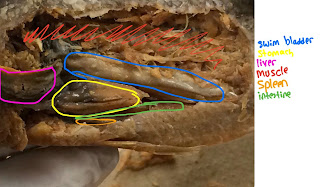- They are carnivorous
- They feed on smaller fish, shellfish, and insect larvae
- They are found in bodies of water such as ponds or streams
- They are most commonly found in the Great Lakes
- Therefore they are a freshwater fish
- They breathe by using their gills. Gills take in water where it flows through the blood. The blood then proceeds to take out the oxygen from the water.
Fun Fact: There are over 6,000 species in the Percidae family.
External Anatomy
Internal Anatomy
 |
| The heart can be difficult to find at first due to it being underneath the liver. It pumps blood to the body. |
 |
| The gills are the breathing mechanism for the fish. |
 |
| They help with the urinary system by removing waste. |
Stomach- breaks down ingested food.
Liver-aids in the digestion of food by secreting bile.
Muscle- helps in the movement of limbs.
Spleen- filters the blood.
Intestine- takes nutrients from digested food.
Incision Guide
 |
| Cut, in a rectangle, just below the dorsal fin, right before the anal fin, just above the pelvic fin, past the pectoral fin. |
https://www.youtube.com/watch?v=6jwjqhhxjoU


No comments:
Post a Comment